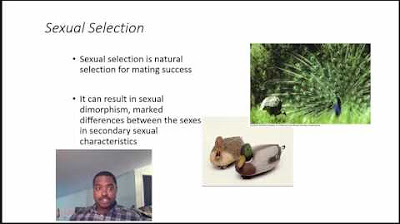GENERAL BIOLOGY 2, MECHANISMS THAT PRODUCE CHANGE IN POPULATIONS
Summary
TLDRIn this lesson, learners explore the mechanisms that drive changes in populations across generations, focusing on genetic variation, mutations, natural selection, gene flow, and genetic drift. Genetic variation arises from inherited traits and mutations in DNA, which can lead to changes in characteristics like eye color or height. Natural selection favors organisms better adapted to their environment, while gene flow involves the movement of alleles between populations. Genetic drift, influenced by random events, can also alter allele frequencies. Finally, Hardy-Weinberg’s principle outlines the conditions under which genetic equilibrium is maintained.
Takeaways
- 😀 Genetic variation refers to individual differences within a population, caused by inherited genetic material from parents.
- 😀 Mutations are the original source of genetic variation and occur when DNA sequences are altered, potentially causing errors in protein production.
- 😀 Most mutations are harmless, but some, like hemophilia, can be serious and affect the body’s normal functioning.
- 😀 Natural selection is the process by which organisms better adapted to their environment tend to survive and reproduce more than those less adapted.
- 😀 In a dark wooded area, gray tree frogs are better camouflaged and thus less likely to be eaten by predators compared to green tree frogs.
- 😀 Gene flow involves the movement of genes into or out of a population through the migration of organisms or their gametes, potentially introducing new alleles.
- 😀 An example of gene flow is a blonde-haired, blue-eyed woman from Sweden moving to India, where her offspring may inherit the blue-eyed alleles.
- 😀 Genetic drift is the change in allele frequencies within a population due to random chance events, often seen in small populations.
- 😀 The northern elephant seal population has reduced genetic variation because of a bottleneck effect caused by hunting in the 1890s.
- 😀 Hardy-Weinberg’s principle suggests that in a population with no mutations, migration, or natural selection, allele frequencies will remain constant over generations.
- 😀 For genetic equilibrium to occur, five conditions must be met: no mutations, no migration, a very large population, random mating, and no natural selection.
Q & A
What is genetic variation?
-Genetic variation refers to individual differences within a population, resulting from the genetic material inherited from parents. These differences can include traits like eye color or height.
What is the role of mutations in genetic variation?
-Mutations are the original source of genetic variation. They are changes or mistakes in the DNA sequence, which can alter the proteins made by the cell, leading to variations in traits among individuals.
How does natural selection work?
-Natural selection is a process where organisms better adapted to their environment tend to survive and reproduce more successfully than those less adapted, leading to changes in the population over generations.
Why do predators have an easier time finding green tree frogs in dark wooded areas?
-Green tree frogs are easier for predators to find in dark wooded areas because their color does not blend in with the surroundings, unlike grey tree frogs, which are better camouflaged.
What is gene flow?
-Gene flow involves the movement of genes into or out of a population, often through the migration of individuals or their gametes, which may introduce new alleles or alter the proportion of existing alleles in the population.
Can you give an example of gene flow?
-An example of gene flow is when a blonde-haired, blue-eyed woman from Sweden moves to India, marries an Indian man, and their offspring inherit the blue-eyed alleles, introducing new genetic material into the local population.
What is genetic drift?
-Genetic drift is a random change in allele frequencies in a population from one generation to the next, often due to chance events rather than natural selection.
What caused the reduced genetic variation in northern elephant seals?
-Northern elephant seals experienced a population bottleneck in the 1890s due to intense hunting, which reduced their population to as few as 20 individuals, leading to reduced genetic variation.
What is the Hardy-Weinberg principle?
-The Hardy-Weinberg principle states that in an infinitely large, random-mating population with no migration, mutation, or natural selection, allele and genotype frequencies will remain constant from generation to generation.
What are the five conditions required for genetic equilibrium to occur according to Hardy-Weinberg?
-The five conditions for genetic equilibrium are: no mutation, no migration, a very large population size, random mating, and no natural selection.
Outlines

This section is available to paid users only. Please upgrade to access this part.
Upgrade NowMindmap

This section is available to paid users only. Please upgrade to access this part.
Upgrade NowKeywords

This section is available to paid users only. Please upgrade to access this part.
Upgrade NowHighlights

This section is available to paid users only. Please upgrade to access this part.
Upgrade NowTranscripts

This section is available to paid users only. Please upgrade to access this part.
Upgrade NowBrowse More Related Video

Population Genetics | The Evolution of Populations | Unit 4. Evolutionary Processes

Grade 11 Earth and Life Science - How Populations of Organisms Change Over Time

Factors that Drive Evolution and Hardy-Weinberg

Genetic drift, bottleneck effect and founder effect | Biology | Khan Academy

Five fingers of evolution - Paul Andersen

Microevolution: What's An Allele Got to Do With It?: Crash Course Biology #12
5.0 / 5 (0 votes)